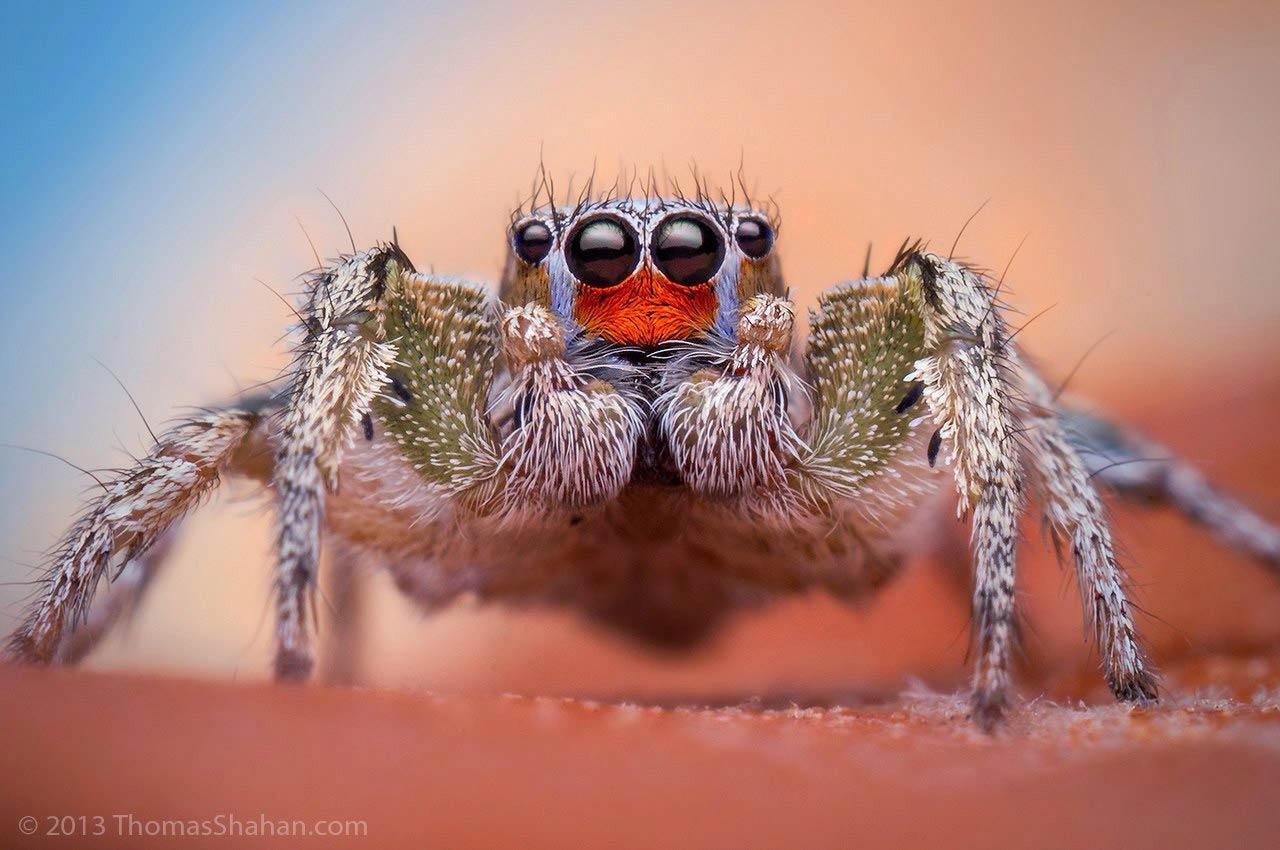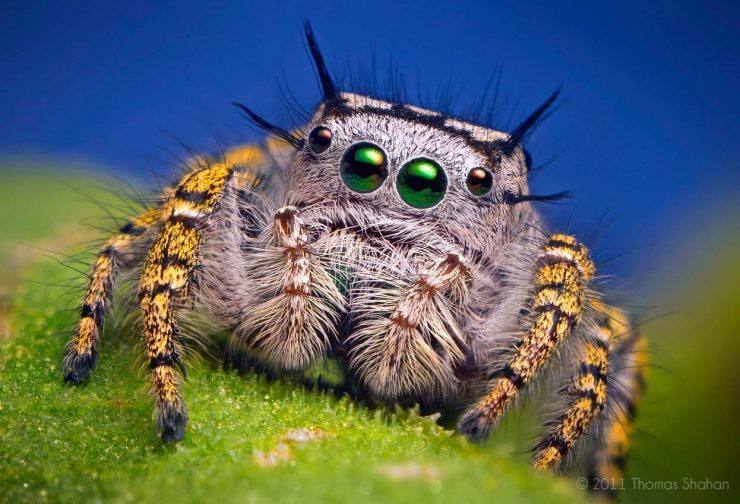In terms of color, I roll back all the saturation levels in the camera so the photographs look kinda washed out right out of the camera, so I’ll set a new white point, and set a new black point, and do a little bit of basic color correction and level adjustments, but all the colors that you see are there… albeit they might be a little enhanced by boosting the contrast of the photograph a little bit, but you know, if the spider is displayed as red, it’s a red spider… and I try to do my best to interpret these colors.
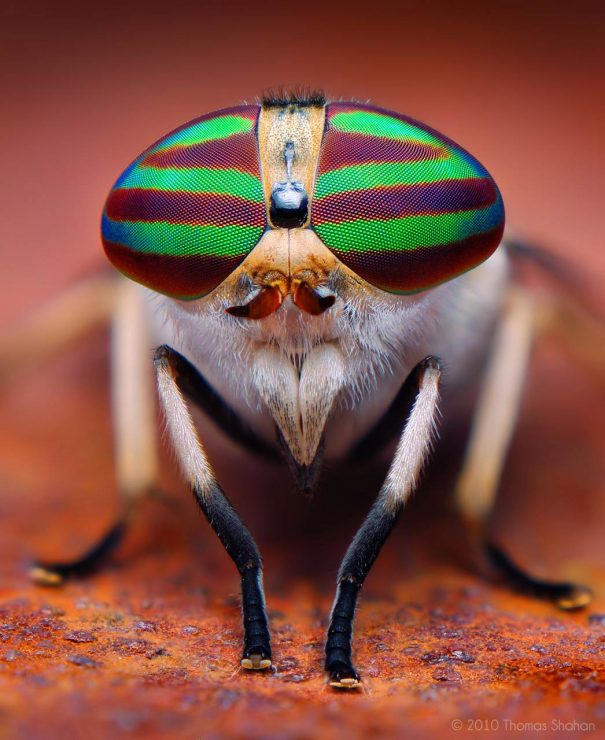
And also, innately, lots of arthropods are very very colorful, due not only to sexual selection, but for warning displays. For example, Phidippus apacheanus is a jumping spider which trying to look like a velvet ant, and velvet ants are a very deep, saturated orange, so the spider is a really deep, intense, saturated orange. Lots of the faces of these jumping spiders are also vibrant and intense and colorful due to sexual selection or displaying to the females. People don’t question the coloration of tropical birds in photos… but when they see macro photographs, it’s easy to be critical and say “Oh, he punched up the colors on this,” which is probably the case sometimes, but these really are colorful bugs, and the backgrounds are often colorful because I’ll find the brightest leaf just as I’ll find the cleanest, brightest jumping spider.
JMG: Are you working with manual flash?
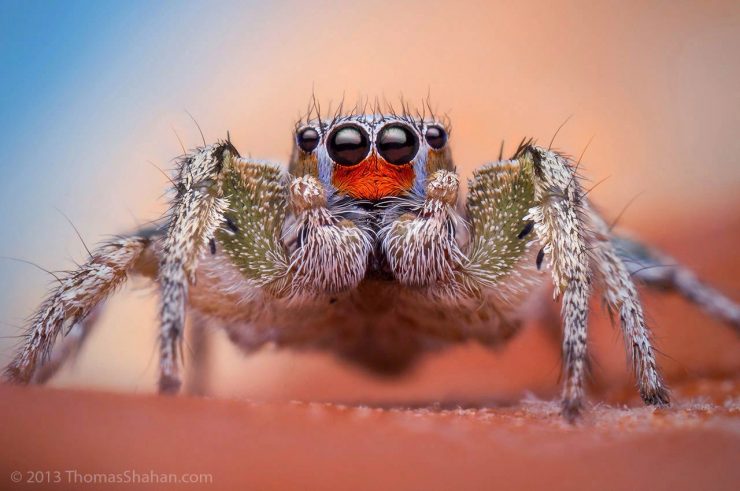
Shahan: There’s no metering of any kind. I’ll be lucky if the flash fires. The flash that I’ve used for most of my photography, up until recently, didn’t have any settings in terms of brightness or other adjustments; the flash that I use now has a couple of different settings, like 1/2 power, 1/4 power, etc, so yeah, its just an old 1970s or 80s Vivitar flash that’s just triggered by an off-camera mount.
What I try to explain to people when they get excited about macro photography and think that they have to spend a bunch of money on equipment is that they just need to take the time to figure out what type of photography they’re interested in; there are always frugal solutions… maybe not with birding or astrophotography… but certainly with macro. I developed a lot of the stuff that I’m interested in by looking at someone’s work on flickr; there’s this Brazilian guy who goes by “Techuser”, though I don’t know his true name (João P. Burini). He used a point and shoot Canon for the longest time with weird little lens attachments, and he used a paper-towel flash diffuser with the pop-up flash. I was incredibly jealous of his photography, and he was probably only using $90 worth of equipment. So it’s not about the equipment, it’s about the time you invest in it.
JMG: I understand that you’re now teaching some seminars?
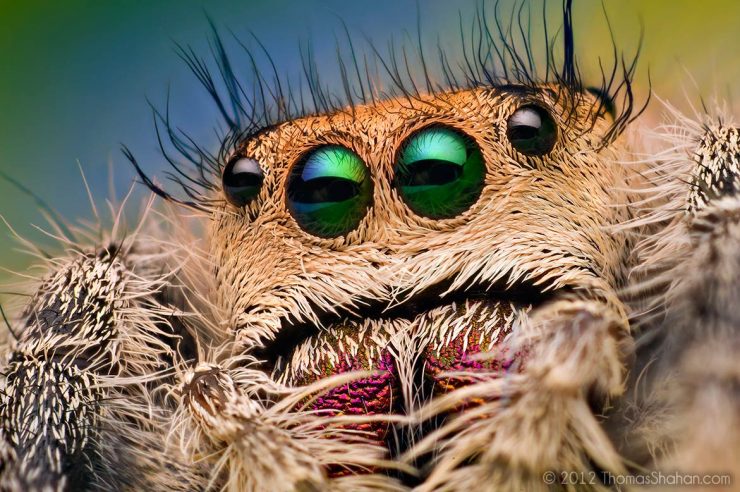
Shahan: Yeah, this has been a relatively new thing that has popped up, because macro photography is kind of a tough thing to teach; so much of it is just trial and error, and you get lucky from time to time and you get a cool shot. There are some simple things you can teach, though, like the methods of magnification, how to do things on a budget, things to consider, basic entomological knowledge… all of these things are really helpful for macro photography. So me, Alex Wild, Piotr Naskrecki, and John Abbott are all going to be in a macro photography workshop in Belize called Bugshot, and we’ve done a couple of Bugshots in the past… one in Missouri, one in Florida. Apparently there’s enough demand for this, and for people who are interested in macro photography it seems to be a worthwhile investment to spend some time with entomologists and get some basic understanding of photography. I’m not an entomologist, but these other guys are. I’m kinda the DIY, don’t stress out about it, have fun, get excited about bugs kind of guy, and they’re the actual entomologists, and they have some more technical presentations about what to look for, and details of exposure, and one of the guys does high-speed flash photography… capturing insects in flight, but we’re all quite different photographers.
You can see more of Thomas Shahan’s work on his flickr page and at his own website. There may also still be space available for the next Bugshot workshop in Belize, if you’re ready to take the plunge.
Questions
Still have questions about macro photography or Thomas’ methods? I spent more time talking with him than I’m willing to transcribe, but if anything is unclear, I may be able to fill in some details for you, so just ask in the “comments” section below.

